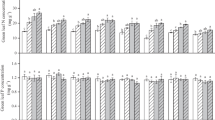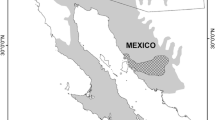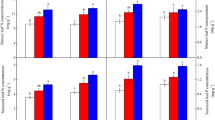Abstract
Both water and nutrients are limiting in arid environments, and desert plants have adapted to these limitations through numerous developmental and physiological mechanisms. In the Mono Basin, California, USA, co-dominant Sarcobatus vermiculatus and Chrysothamnus nauseosus ssp. consimilis are differentially N and P limited. We hypothesized that low leaf N resorption contributes to N-limitation in Sarcobatus and that low leaf P resorption contributes to P-limitation in Chrysothamnus. As predicted, Sarcobatus resorbed proportionally 1.7-fold less N than Chrysothamnus, but reduced leaf P in senescent leaves to lower levels than Chrysothamnus (8.0–10.8-fold lower based on leaf area or mass, respectively), consistent with N, but not P limitations in Sarcobatus. Again, as predicted, Chrysothamnus resorbed proportionally 2.0-fold less P than Sarcobatus yet reduced leaf N in senescent leaves to lower levels than Sarcobatus (1.8–1.3-fold lower based on leaf area or mass, respectively), consistent with P, but not N limitations in Chrysothamnus. Leaf N and P pools were approximately 50% of aboveground pools in both species during the growing season, suggesting leaf resorption can contribute significantly to whole plant nutrient retention. This was consistent with changes in leaf N vs. P concentration as plants grew from seedlings to adults. Our results support the conclusion that N-limitation in Sarcobatus and P-limitation in Chrysothamnus are in part caused by physiological (or other) constraints that prevent more efficient resorption of N or P, respectively. For these species, differential nutrient resorption may be a key physiological component contributing to their coexistence in this saline, low resource habitat.
Similar content being viewed by others
References
Aerts R. (1996). Nutrient resorption from senescing leaves of perennials: are there general patterns?. Journal of Ecology 84:597–608
Aerts R. (1997). Nitrogen partitioning between resorption and decomposition pathways: a trade-off between nitrogen use efficiency and litter decomposability?. Oikos 80:603–606
Aerts R., Chapin III F.S. (2000). The mineral nutrition of wildland plants re-visited: a re-evaluation of processes and patterns. Advances in Ecological Research 30:1–67
Carrera A.L., Sain C.L., Bertiller M.B. (2001). Patterns of nitrogen conservation in shrubs and grasses in the Patagonian Monte, Argentina. Plant and Soil 224:185–193
Chapin III F.S., Kedrowski R.A. (1983). Seasonal changes in nitrogen and phosphorus fractions and autumn retranslocation in evergreen and deciduous taiga trees. Ecology 64:376–391
Donovan L.A., Richards J.H. (2000). Juvenile shrubs show differences in stress tolerance, but no competition or facilitation, along a stress gradient. Journal of Ecology 88:1–16
Donovan L.A., Linton M.J., Richards J.H. (2001). Predawn plant water potential does not necessarily equilibrate with soil water potential under well-watered conditions. Oecologia 129:328–335
Donovan L.A., Richards J.H., Linton M.J. (2003). Magnitude and mechanisms of disequilibrium between predawn plant and soil water potentials. Ecology 84:463–470
Donovan L.A., Richards J.H., Muller M.W. (1996). Water relations and leaf chemistry of Chrysothamnus nauseosus ssp. consimilis (Asteraceae) and Sarcobatus vermiculatus (Chenopodiaceae). American Journal of Botany 83:1637–1646
Donovan L.A., Richards J.H., Schaber E.J. (1997). Nutrient relations of the halophytic shrub, Sarcobatus vermiculatus, along a soil salinity gradient. Plant and Soil 190:105–117
Drenovsky R.E., Richards J.H. (2004). Critical N:P values: predicting nutrient deficiencies in desert shrublands. Plant and Soil 259:59–69
Drenovsky R.E., Richards J.H. (2005). Nitrogen addition increases fecundity in the desert shrub Sarcobatus vermiculatus. Oecologia 143:349–356
Eckstein R.L., Karlsson P.S.,Weih M. (1999). Leaf life span and nutrient resorption as determinants of plant nutrient conservation in temperate-arctic regions. New Phytologist 143:177–189
Fisher F.M., Parker L.W., Anderson J.P., Whitford W.G. (1987). Nitrogen mineralization in a desert soil: interacting effects of soil moisture and nitrogen fertilizer. Soil Science Society of America Journal 51:1033–1041
Fort K.P., Richards J.H. (1998). Does seed dispersal limit initiation of primary succession in desert playas?. American Journal of Botany 85:1722–1731
Jackson R.B., Caldwell M.M. (1989). The timing and degree of root proliferation in fertile-soil microsites for three cold desert perennials. Oecologia 81:149–153
Jackson R.B., Manwaring J.H., Caldwell M.M. (1990). Rapid physiological adjustment of roots to localized soil enrichment. Nature 344:58–60
James J.J. and Richards J.H. 2005. Plant N capture from pulses: effects of pulse size, growth rate, and other soil resources. Oecologia (in press)
Jordan P.W., Nobel P.S. (1984). Thermal and water relations of roots of desert succulents. Annals of Botany 54:705–717
Killingbeck K.T. (1996). Nutrients in senesced leaves: keys to the search for potential resorption and resorption proficiency. Ecology 77:1716–1727
Lajtha K. (1987). Nutrient reabsorption efficiency and the response to phosphorus fertilization in the desert shrub Larrea tridentata (DC.) Cov. Biogeochemistry 4:265–276
Lajtha K., Klein M. (1988). The effect of varying nitrogen and phosphorus availability on nutrient use by Larrea tridentata, a desert evergreen shrub. Oecologia 75:348–353
Lajtha K., Schlesinger W.H. (1988). The biogeochemistry of phosphorus cycling and phosphorus availability along a desert soil chronosequence. Ecology 69:24–39
May J.D., Killingbeck K.T. (1992). Effects of preventing nutrient resorption on plant fitness and foliar nutrient dynamics. Ecology 73:1868–1878
Misra A., Tyler G. (2000). Effects of wet and dry cycles in calcareous soil on mineral nutrient uptake of two grasses, Agrostis stolonifera L. and Festuca ovina L. Plant and Soil 224:297–303
Neter J., Kutner M.H., Nachtsheim C.J.,Wasserman W. (1996). Applied Linear Statistical Models. McGraw-Hill, Boston
Noy-Meir I. (1973). Desert ecosystems: environment and producers. Annual Review of Ecology and Systematics 5:25–51
SAS Institute. (2001). SAS/STAT User’s Guide. Version 8.1. SAS Institute, Cary
Schaber E.J. (1994). Salinity and nutrient effects on the germination and growth of Chrysothamnus nauseosus and Sarcobatus vermiculatus in playa dunes around Mono Lake, CA. MSc thesis, University of California, Davis CA
Schimel D.S., Parton W.J. (1986). Microclimatic controls of nitrogen mineralization and nitrification in short-grass steppe soils. Plant and Soil 93:347–357
Snyder K.A., Donovan L.A., James J.J., Tiller R.L., Richards J.H. (2004). Extensive summer water pulses do not necessarily lead to canopy growth of Great Basin and northern Mojave Desert shrubs. Oecologia 141:325–334
Tilman D., Pacala S. (1993). The maintenance of species richness in plant communities. In: Ricklefs R.E., Schluter D. (eds) Species Diversity in Ecological Communities. University of Chicago Press, Chicago, pp 414
Toft C.A., Elliott-Fisk D.E. (2002). Patterns of vegetation along a spatiotemporal gradient on shoreline strands of a desert basin lake. Plant Ecology 158:21–39
van Breemen N. (1995). Nutrient cycling strategies. Plant and Soil 168–169: 321–326
van Heerwaarden L.M., Toet S., Aerts R. (2003). Current measures of nutrient resorption efficiency lead to a substantial underestimation of real resorption efficiency: facts and solutions. Oikos 101:664–669
West N.E. (1983). Intermountain salt-desert shrubland. In: West N.E. (eds) Temperate Deserts and Semi-deserts Volume 5 Ecosystems of the World. Elsevier Scientific Publishing Company, New York, pp 522
West N.E. (1991). Nutrient cycling in soils of semiarid and arid regions. In: Skujins J. (eds) Semiarid Lands and Deserts: Soil Resources and Reclamation. Marcel Dekker, New York, pp 668
Acknowledgements
We thank J. James, J. Drewitz, J. Stimac, A.␣Breen, M. Caird, A. Dain-Owens, J. Drenovsky, and K. Snyder for laboratory and field assistance and L. Donovan, A. Läuchli, J. James, J.␣Drewitz, J. Erskine, and J. Stimac for manuscript review. A Jastro-Shields Research Fellowship, a UC Davis Humanities Research Award, National Science Foundation grant IBN-99–03004, and the California Agricultural Experiment Station supported this work.
Author information
Authors and Affiliations
Corresponding author
Rights and permissions
About this article
Cite this article
Drenovsky, R., Richards, J. Low leaf N and P resorption contributes to nutrient limitation in two desert shrubs. Plant Ecol 183, 305–314 (2006). https://doi.org/10.1007/s11258-005-9041-z
Received:
Accepted:
Published:
Issue Date:
DOI: https://doi.org/10.1007/s11258-005-9041-z




